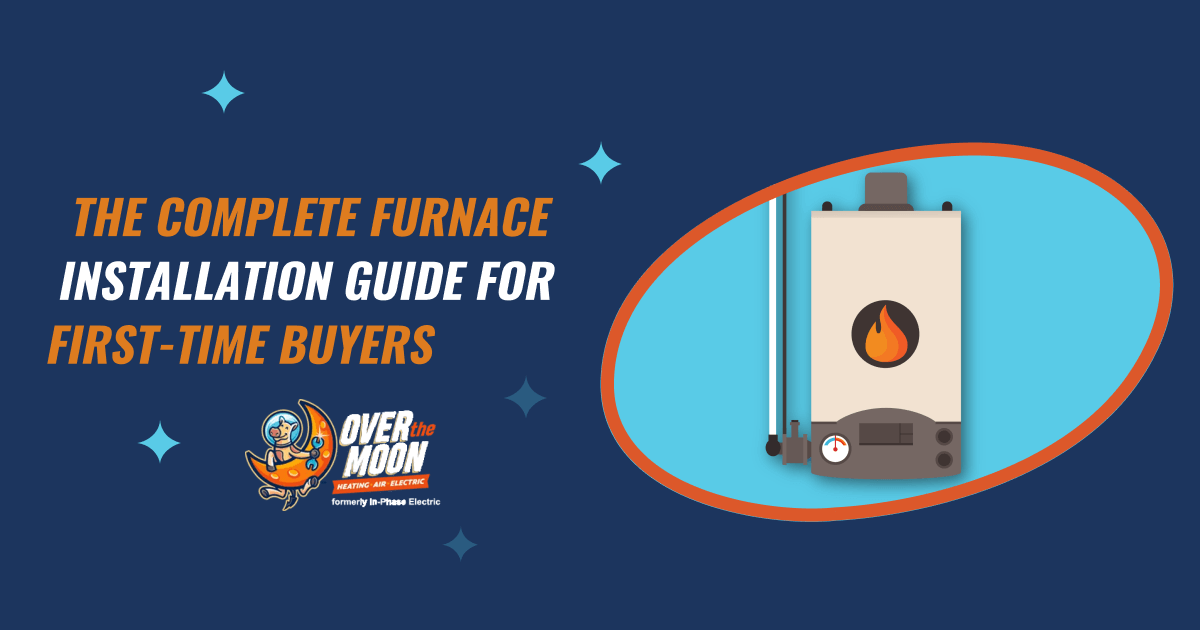Over the Moon is an expert furnace installation contractor in Oconomowoc, Wisconsin. We prioritize high-quality customer service and educating our clients so they can make the right decisions. If it’s your first-time buying a furnace, whether you’ve just built/purchased a new home or an old unit is ready for replacement, this complete guide can help the process go smoothly.
When to Get a New Furnace?
Your old furnace may be failing or need expensive repairs. But how do you know it’s time to make a move? One is if your furnace is over 15 years old. Nonetheless, age isn’t the only factor as some older furnaces meet owners’ needs just fine. These are some key signs you want to look for:
- Heating bills rise without any change in usage, weather conditions, or seasonal rates.
- Your furnace requires frequent mechanical and electrical repairs, which continue adding parts and labor costs.
- The unit starts making loud noises, which can mean the blower, motor, or heat exchanger is about to fail.
- The heat exchanger is visibly cracked; combined with carbon monoxide detectors going off when your furnace cycles, this means it’s time for immediate professional care.
- Rust is visible on the furnace or inside the blower compartment; it’s a sure sign you should plan for furnace replacement.
Importance of Your Furnace Size
The furnace must be properly sized for your home. If it’s too large, it will cycle on and off too frequently, increasing wear and tear. This will also waste energy and reduce the lifespan of the unit. An appliance that’s too small for your home won’t provide adequate comfort, especially during cold spells.
Home size is just one element of the furnace sizing equation. It’s also important to consider your home’s layout, number/size of windows, the cubic footage you want to heat, and your overall current energy efficiency. The number of people in your household is a factor as well. You also need to consider the temperature preferences of every member of your family.
By considering these factors, and having a professional seal air leaks, add insulation, and perform a Manual J HVAC load calculation, furnace installation can maximize comfort and save energy and money.
Also make sure:
- Ductwork is properly sized to ensure sufficient airflow.
- The new furnace will fit in the physical area it will occupy.
- Gas lines and electrical wiring are properly set up.
- To determine whether a new chimney flue liner or PVC drain line is needed.
- To identify any needs for equipment or calibration so your furnace and A/C are compatible.
Furnace Efficiency
Combustion furnaces are rated by measuring their annual fuel utilization efficiency, or AFUE. This measures how efficiently a unit converts gas into heating energy. If a furnace has an AFUE rating of 80, it uses 80% of its fuel for heating. Older models are inherently less efficient while high-efficiency models can achieve 90 AFUE or better. You can also boost energy efficiency by turning the thermostat down just a couple of degrees in winter or by installing a programmable or smart thermostat.
Furnace Types/Fuel Sources
Furnaces are categorized into types based on the fuel they use. Your primary choices in this area include:
- Natural Gas: The most economical energy source for furnaces, natural gas is obtained from your municipal gas line. Gas furnaces are less expensive to run (compared to electric furnaces), but often require more maintenance. A well-maintained gas furnace can last 10 years longer than an electric one.
- Electric: Using electric heating elements, the system heats the air and, like a gas furnace, pushes heated air through ductwork to warm each room. Electric furnaces are usually smaller than other types. They’re an option if you don’t have a natural gas line. However, operating costs can vary significantly depending on local electricity rates.
- Oil: An oil-fueled furnace is also an alternative to a natural gas system. Oil is less efficient than gas for heating, so your energy bills may be higher. But an oil furnace does produce more heat and can heat your home faster. It also burns cleaner (not releasing smoke, soot, or odors) and is not explosive. Oil furnace installation can therefore improve safety.
- Propane: Propane, which is stored in an outdoor container, is used as a fuel source. It burns in the heat exchanger to warm circulating air. A propane furnace can fit in a tighter space. Since it’s not powered by electricity, it can be a convenient choice if power outages are common in your area.
Features to Look For
If you’re installing a new furnace, you want one that offers the most comfort, safety, and efficiency as well as value. To ensure you get everything you need, here are some of the most important features:
- Durable Heat Exchanger: A corrosion-resistant stainless steel heat exchanger should last the longest. Stainless steel is also strong, making it more resistant to thermal fatigue.
- Dual Heat Exchanger: The secondary heat exchanger allows the furnace to draw more heat from the air it burns; it also has a special lining to protect it against corrosive acids.
- Variable Speed Blower: Converts AC power to DC, so uses less electricity, and can adapt to your heating needs. It delivers heat more slowly and consistently, while also operating more quietly.
- Variable Heat Output: A variable-speed furnace is able to automatically adjust output. This means it can accommodate a range of heating requirements.
- High-Efficiency Filters: Some of the more efficient furnaces are equipped with HEPA or electrostatic filters that trap a wider range of particulates, keeping indoor air cleaner and reducing strain on the furnace.
- More Efficient Ignition Systems: Intermittent, direct-spark, or hot-surface ignition elements eliminate the need for a pilot light, which often runs inefficiently and can create safety hazards.
- Two-Stage Gas Valve: Runs in the first stage to accommodate moderate heating requirements and, in cold temperatures, the valve switches to the second stage, providing control over energy consumption and output.
- Furnace Dehumidifier: An add-on comfort feature that regulates humidity levels throughout your home. It can add to the cost significantly, but has notable benefits in terms of comfort and efficiency.
- Zoned Heating: Uses multiple thermostats, dampers, and a sophisticated controller to manage different heating or cooling requirements throughout your home; this is especially useful for larger properties.
Cost
A 90 AFUE furnace or higher can cost $1,000 more than an 80 AFUE system. In many cases, you can recoup the added cost with lower fuel bills, especially in areas with cold winters. Local gas/electricity rates and type of insulation also impact how quickly you recover your investment. Generally, a single-stage furnace costs between $2,000 and $3,500 to install, a two-stage system from $2,500 to $4,000, and a multi-stage unit from $5,000 to $7,500, including parts and labor, according to Angi’s List.
Cost can also be affected by other factors such as installation fees, additional upgrades to your heating system, and modifications or repairs to vents, chimneys, and ductwork.
However, savings may be possible via rebates from your utility company or through the Energy Star rebate program.
Warranty
A manufacturer warranty should cover parts. A new furnace often has a warranty that’s good for five to 10 years. To take effect, the warranty must be registered. Installation warranties or extended warranties are often available to purchase and provide additional coverage.
Preparing for Furnace Installation
Your HVAC contractor should discuss every detail of the equipment they’re installing after fully evaluating your home. Ask to see the model number of the unit, so you can do further research. Otherwise, there’s little you need to do on your own. The installation crew should put down floor coverings anywhere they work. Before installation, they’ll run a series of safety checks and then remove old equipment, including the old furnace and anything that’s physically connected to it, such as electrical wiring, gas lines, venting, and ductwork.
The area will be cleaned, and any necessary alterations made, before the new furnace is installed. Power to the circuit for the area will be shut off as well. A variety of tools will be used to install the furnace and reconnect and seal all lines it’s connected to. Once the furnace is commissioned, the contractor will review the process and explain how to operate and care for the unit, including changing the filter.
Does My Furnace Have to Go in the Basement?
Not necessarily. Some people choose to put a furnace in their garage or a well-equipped closet. Others even opt for furnace installation in their attic. Modern furnaces can often be installed vertically or horizontally, making attic installation easy. They can be vented directly to the roof, which reduces installation costs.
People less frequently use their attic space so it can be a good spot for a furnace. Using this area also clears storage space in your basement, garage, or closet. And being higher up from the ground reduces the risk of flood damage to your heating system.
Contact Over the Moon for Furnace Installation Help
We offer many choices when it comes to installing a new furnace. If it’s the first time you need a new heater, our trained technicians will explain all the details and options and determine the best model, size, and features for your home. When you need a new furnace installed, schedule your appointment with us online or call 262-320-3822 for immediate assistance.

